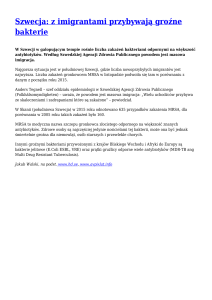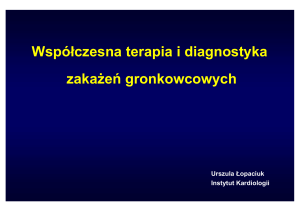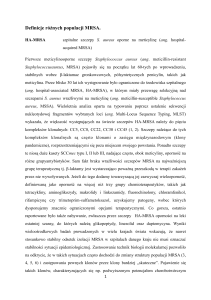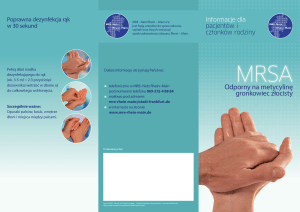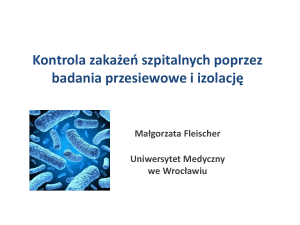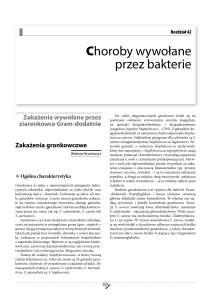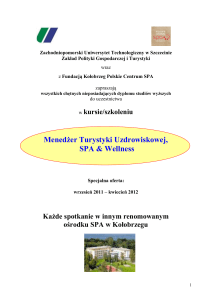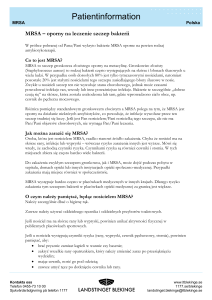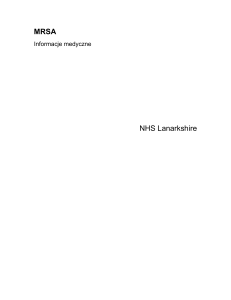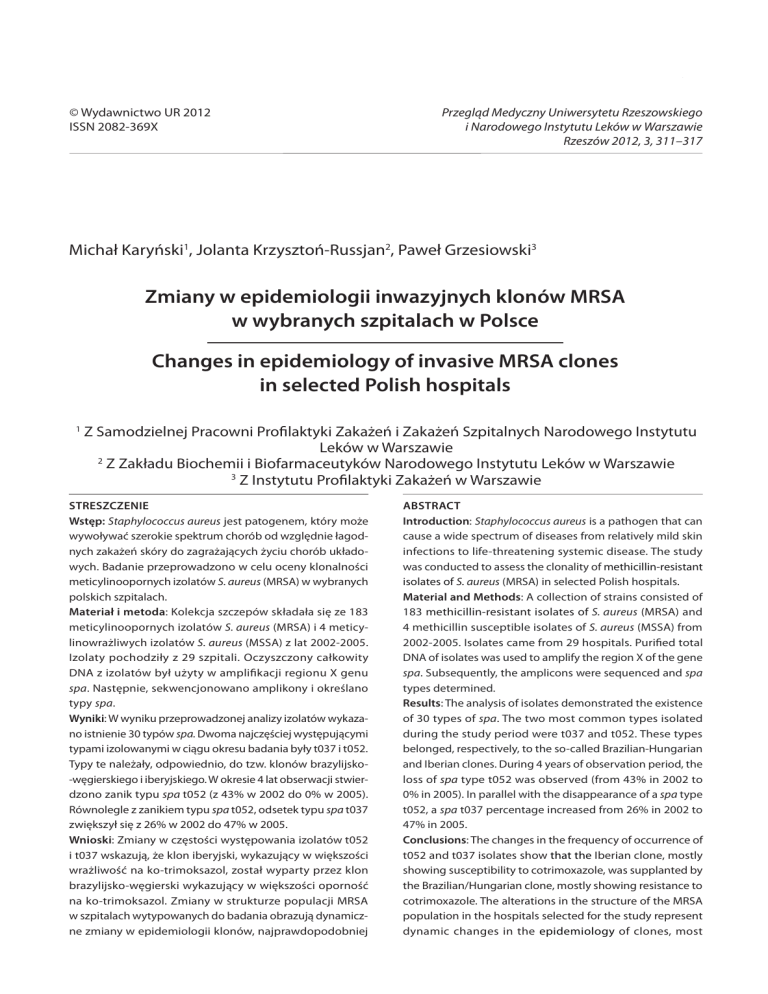
Karyński, Krzysztoń-Russjan, Grzesiowski Zmiany w epidemiologii inwazyjnych klonów MRSA w wybranych szpitalach w Polsce
© Wydawnictwo UR 2012
ISSN 2082-369X
311
Przegląd Medyczny Uniwersytetu Rzeszowskiego
i Narodowego Instytutu Leków w Warszawie
Rzeszów 2012, 3, 311–317
Michał Karyński1, Jolanta Krzysztoń-Russjan2, Paweł Grzesiowski3
Zmiany w epidemiologii inwazyjnych klonów MRSA
w wybranych szpitalach w Polsce
Changes in epidemiology of invasive MRSA clones
in selected Polish hospitals
1
Z Samodzielnej Pracowni Profilaktyki Zakażeń i Zakażeń Szpitalnych Narodowego Instytutu
Leków w Warszawie
2
Z Zakładu Biochemii i Biofarmaceutyków Narodowego Instytutu Leków w Warszawie
3
Z Instytutu Profilaktyki Zakażeń w Warszawie
Streszczenie
Wstęp: Staphylococcus aureus jest patogenem, który może
wywoływać szerokie spektrum chorób od względnie łagodnych zakażeń skóry do zagrażających życiu chorób układowych. Badanie przeprowadzono w celu oceny klonalności
meticylinoopornych izolatów S. aureus (MRSA) w wybranych
polskich szpitalach.
Materiał i metoda: Kolekcja szczepów składała się ze 183
meticylinoopornych izolatów S. aureus (MRSA) i 4 meticylinowrażliwych izolatów S. aureus (MSSA) z lat 2002-2005.
Izolaty pochodziły z 29 szpitali. Oczyszczony całkowity
DNA z izolatów był użyty w amplifikacji regionu X genu
spa. Następnie, sekwencjonowano amplikony i określano
typy spa.
Wyniki: W wyniku przeprowadzonej analizy izolatów wykazano istnienie 30 typów spa. Dwoma najczęściej występującymi
typami izolowanymi w ciągu okresu badania były t037 i t052.
Typy te należały, odpowiednio, do tzw. klonów brazylijsko-węgierskiego i iberyjskiego. W okresie 4 lat obserwacji stwierdzono zanik typu spa t052 (z 43% w 2002 do 0% w 2005).
Równolegle z zanikiem typu spa t052, odsetek typu spa t037
zwiększył się z 26% w 2002 do 47% w 2005.
Wnioski: Zmiany w częstości występowania izolatów t052
i t037 wskazują, że klon iberyjski, wykazujący w większości
wrażliwość na ko-trimoksazol, został wyparty przez klon
brazylijsko-węgierski wykazujący w większości oporność
na ko-trimoksazol. Zmiany w strukturze populacji MRSA
w szpitalach wytypowanych do badania obrazują dynamiczne zmiany w epidemiologii klonów, najprawdopodobniej
Abstract
Introduction: Staphylococcus aureus is a pathogen that can
cause a wide spectrum of diseases from relatively mild skin
infections to life-threatening systemic disease. The study
was conducted to assess the clonality of methicillin-resistant
isolates of S. aureus (MRSA) in selected Polish hospitals.
Material and Methods: A collection of strains consisted of
183 methicillin-resistant isolates of S. aureus (MRSA) and
4 methicillin susceptible isolates of S. aureus (MSSA) from
2002-2005. Isolates came from 29 hospitals. Purified total
DNA of isolates was used to amplify the region X of the gene
spa. Subsequently, the amplicons were sequenced and spa
types determined.
Results: The analysis of isolates demonstrated the existence
of 30 types of spa. The two most common types isolated
during the study period were t037 and t052. These types
belonged, respectively, to the so-called Brazilian-Hungarian
and Iberian clones. During 4 years of observation period, the
loss of spa type t052 was observed (from 43% in 2002 to
0% in 2005). In parallel with the disappearance of a spa type
t052, a spa t037 percentage increased from 26% in 2002 to
47% in 2005.
Conclusions: The changes in the frequency of occurrence of
t052 and t037 isolates show that the Iberian clone, mostly
showing susceptibility to cotrimoxazole, was supplanted by
the Brazilian/Hungarian clone, mostly showing resistance to
cotrimoxazole. The alterations in the structure of the MRSA
population in the hospitals selected for the study represent
dynamic changes in the epidemiology of clones, most
312
Prz. Med. Uniw. Rzesz. Inst. Leków, 2012, 3, 311–317
związane z presją selekcyjną antybiotyków stosowanych w
terapii zakażeń szpitalnych.
Słowa kluczowe: Staphylococcus aureus, MRSA, typ spa, klon
probably related to the selection pressure of antibiotics used
in the therapy of hospital infections.
Key words: Staphylococcus aureus, MRSA, spa type, clone
Praca została wykonana w Narodowym Instytucie Leków
w Warszawie
The work was done at the National Institute of Medicines
in Warsaw
Wprowadzenie
Introduction
S. aureus może powodować szereg miejscowych zakażeń,
najczęściej skóry, ran i tkanek miękkich oraz inwazyjnych
zakażeń, takich jak sepsa, zapalenie wsierdzia czy stawów.
U ludzi S. aureus kolonizuje najczęściej błony śluzowe
górnych dróg oddechowych, przewodu pokarmowego,
moczowo-płciowego oraz skórę dłoni, małżowin usznych,
pachwin i głowy. Po krótkim okresie kolonizacji może
dochodzić do utrzymywania się tego drobnoustroju
w organizmie człowieka, bez wywoływania cech zakażenia, tj. nosicielstwa. Okres nosicielstwa S. aureus
u każdego człowieka jest różny i stanowi wypadkową
wielu czynników, m.in.: wieku, występowania choroby
przewlekłej, defektów immunologicznych, hospitalizacji
oraz od uwarunkowań genetycznych człowieka wpływających na podatność na zakażenia bakteryjne, a z drugiej
strony od potencjału epidemicznego szczepu S. aureus.
Wykazano istotną statystycznie korelację, występowania
przewlekłego nosicielstwa S. aureus, np. z występowaniem
polimorfizmu o charakterze SNP (ang. single nucleotide
polimorphism) różnych genów gospodarza, np. genu
kodującego białko C-reaktywne (typ SNP: C2042T
i C1184T), czy genu kodującego interleukinę 4 (typ SNP:
C524T) [1]. Z drugiej strony sugeruje się, że obecność
określonych cech genetycznych gospodarza może także
uniemożliwiać, bądź utrudniać kolonizację S. aureus.
Zjawisko kolonizacji sprzyja utrzymywaniu się tego
drobnoustroju w populacji, zaś nosiciel bezobjawowy,
zwłaszcza przewlekły nosiciel, może być źródłem rozprzestrzeniania się danego szczepu w otoczeniu.
S. aureus can cause a number of local infections, most
commonly the skin, wound and soft tissue infections
and invasive infections such as sepsis, endocarditis,
and arthritis. In humans, S. aureus usually colonizes
the mucous membranes of upper respiratory tract,
gastrointestinal tract, urogenital tract and the skin of
hands, ears, groin and head. After a brief period of
colonization the micro-organism may remain in the
human body, without causing characteristics of the
infection, i.e., a carrier. S. aureus colonization period
in every human being is different and is a result of many
factors, including age, chronic disease, immune defects,
hospitalization, and human genetic factors affecting
susceptibility to bacterial infection, on the other hand
it depends on the epidemic potential of S. aureus strain.
A statistically significant correlation of the presence
of chronic carrier-state of S. aureus, with, e.g., the
occurrence of a polymorphism SNP (single nucleotide
polimorphism) of different genes of a host, e.g., the gene
encoding the C-reactive protein (SNP type: C2042T
and C1184T) or the gene encoding interleukin-4 (type
SNP: C524T) [1]. On the other hand, it is suggested
that the presence of specific genetic characteristics of
the host can also prevent or inhibit colonization of S.
aureus. The phenomenon of colonization favors the
persistence of this microorganism in the population,
and an asymptomatic carrier, especially a chronic
carrier, can be a source of spread of the given strain in
the environment.
Znaczenie szczepów lekoopornych i metody
ich badania
The importance of drug-resistant strains and
methods of their study
Od momentu pojawienia się pierwszego szczepu opornego na meticylinę, MRSA (ang. methicillin-resistant S.
aureus) w 1961 r. notuje się wzrost zakażeń o tej etiologii,
a w ostatnim dwudziestoleciu także wzrost zakażeń
powodowanych przez szczepy VISA (ang. vancomycin-intermediate S. aureus). W latach 90. poprzedniego
stulecia wykazano charakter klonalny rozprzestrzeniania
się szczepów S. aureus odpowiedzialnych za epidemie
szpitalne. Było to możliwe dzięki zastosowaniu metod
biologii molekularnej, pozwalających na określenie
stopnia pokrewieństwa badanych izolatów S. aureus,
w toku typowania genetycznego. Aktualnie dostępnych
jest wiele metod i strategii typowania, które różnią się
pod względem możliwości określenia stopnia zróżnicowania genetycznego badanych izolatów i wielkością
Since the emergence of the first methicillin resistant strain,
MRSA (Methicillin-resistant S. aureus) in 1961 there has
been an increase in the incidence of this etiology, and in
the last two decades the increase in infections caused by
strains of VISA (Vancomycin-intermediate S. aureus) took
place as well. In the 90-ies of the last century the clonal
character of spreading of S. aureus strains was shown,
responsible for the outbreaks of hospital epidemics.
This was made possible through the use of molecular
biology methods to identify the degree of relatedness of
the tested S. aureus isolates, in the course of the genetic
typing. Currently, there are a lot of typing methods and
strategies that differ in their ability to determine the degree
of genetic diversity of isolates tested and in the size of
analyzed DNA fragment. The most accurate method of
Karyński, Krzysztoń-Russjan, Grzesiowski Zmiany w epidemiologii inwazyjnych klonów MRSA w wybranych szpitalach w Polsce
analizowanego fragmentu DNA. Najbardziej dokładną
metodą pozwalającą na określenie stopnia zróżnicowania
szczepów bakteryjnych jest sekwencjonowanie genomów.
Z uwagi na możliwości, koszty i dostępność jest to strategia przyszłości.
Najstarsza i najprostsza z metod, RAPD (ang. randomly amplified polymorfic DNA), pozwala na określenie
polimorfizmu losowo namnożonych fragmentów DNA,
z zastosowaniem pojedynczych, specyficznych do wielu
fragmentów genomu, starterów reakcji PCR. Metoda ta
często stosowana była w latach 90. i na początku nowego
stulecia do określania klonalności badanych izolatów.
Z uwagi na trudności z jej standaryzacją uzyskane wyniki
pozwalały na analizę danych z pojedynczego badania.
Bardziej precyzyjne wyniki można uzyskać z zastosowaniem metody RLFP (ang. restriction fragments
length polymorphism), opartej na analizie polimorfizmu
długości fragmentów restrykcyjnych DNA genomowego, np. PFGE (ang. pulsed field gel electrophoresis) lub
określonego fragmentu DNA, np. genu, czy transpozonu.
Wyniki uzyskane z zastosowaniem wariantów metod
RLFP pozwalały na utworzenie strategii typowania, złożonej z typowania PFGE (uznawanego do tej pory jako
„gold standard”) uzupełnionego, w przypadku MRSA,
o typowanie locus mecA i transpozonu Tn554, i popularnej jeszcze na początku nowego stulecia. W wyniku
zastosowania takiej strategii możliwe było określenie
stopnia pokrewieństwa badanych izolatów podczas
pojedynczego badania, a także na określenie z dużym
prawdopodobieństwem ich pokrewieństwa ze szczepami
epidemicznymi rozprzestrzenionymi na całym świecie,
przy zastosowaniu wystandaryzowanych warunków
badania i szczepów wzorcowych.
W latach 90. w typowaniu S. aureus metodą RLFP
badano polimorfizm genów zawierających fragmenty
polimorficzne, np. spa, coa i kodujących odpowiednio
białko A i białko koagulazy wolnej. Te przeglądowe
szybkie metody pozwalały jedynie na uzyskanie wstępnej
informacji o klonalności badanych izolatów, bez możliwości określenia stopnia pokrewieństwa.
Przykładem nowszej metody pozwalającej na określenie polimorfizmu loci gronkowcowych: sdr, clfA, clfB,
sspA i spa z zastosowaniem złożonej reakcji PCR (ang.
multiplex PCR) jest MLVF (ang. multiple-locus variable
number tandem repeat fingerprinting). Oparta jest ona
na badaniu zmienności liczby tandemowych powtórzeń
(ang. variable numbers of tandems repeat, VNTR) wymienionych genów. Uzyskany wynik pozwala na określenie
stopnia pokrewieństwa i klonalności badanych izolatów,
po wystandaryzowaniu metody [2, 3].
W celu określenia pokrewieństwa izolatów zebranych
w długim okresie czasu i pochodzących z odległych
ośrodków, potrzebne jest zastosowanie innej metody, np.
MLST (ang. multilocus sequence typing), z jednej strony
o mniejszej sile różnicowania, z drugiej zaś pozwalającej
313
determining the degree of differentiation of bacterial
strains is sequencing the genomes. Due to the possibilities,
cost and availability this is a strategy for the future.
The oldest and simplest method, RAPD (randomly
amplified polymorfic DNA), allows to determine the
polymorphism of randomly proliferated DNA fragments,
using a single, specific to a number of fragments of the
genome, primers of PCR reactions. This method was often
used in the 90’s and at the beginning of the new century
to determine the clonality of isolates tested. Due to the
difficulty of its standardizing, the results obtained allowed
to analyze data from a single test.
More accurate results can be obtained using
the method of RLFP (Restriction fragments length
polymorphism) based on the analysis of polymorphism
of the length of restriction fragments of genomic DNA,
such as PFGE (pulsed field gel electrophoresis) or a specific
piece of DNA, such as a gene, or a transposon. The results
obtained using variants of FRLP methods allowed for the
creation of typing strategy, consisting of PFGE typing (so
far recognized as the “gold standard”), supplemented,
in the case of MRSA, by the typing of mecA locus and
transposon Tn554, being still popular at the beginning of
the new century. As a result of this strategy it was possible
to determine the degree of relatedness of isolates tested in
a single test, and the determination, with a high degree of
likelihood, of their relationship with the epidemic strains
widely distributed around the world, using a standardized
test conditions and reference strains.
In the 90’s, in the typing of S. aureus by the method
of RLFP researchers studied polymorphisms of genes
containing polymorphic fragments, such as a spa, coa
and appropriately encoding protein A and free coagulase
protein. These rapid review methods allowed only to
obtain preliminary information on the clonality of isolates
tested, without the possibility to determine the degree of
relatedness.
An example of a newer method for the determination
of the polymorphism of staphylococcal loci: sdr, clfA,
clfB, sspA and spa with the use of complex PCR reaction
(called multiplex PCR) is MLVF (multiple-locus variable
number tandem repeat fingerprinting). It is based on
the study of variability of the number of tandem repeats
(called variable numbers of tandems repeat, VNTR) of
these genes. The result allows to determine the degree of
kinship and clonality of isolates tested, after standardising
the method [2, 3].
In order to determine the relatedness of isolates
collected over a long period of time and from remote
centers, another method such as MLST is needed
(multilocus sequence typing), on the one hand with a
weaker differentiation, on the other allowing to determine
the relationship. MLST typing allows to determine the
epidemiological relatedness of S. aureus dispersed globally,
and is used to study the evolutionary variability of MRSA
314
określić pokrewieństwo. Typowanie MLST pozwala na
określenie pokrewieństwa epidemiologicznego S. aureus
rozprzestrzenionych globalnie, a także służy do badań nad
ewolucyjną zmiennością MRSA i MSSA (ang. methicillin-susceptible S. aureus). Metoda ta oparta jest na analizie
sekwencji nukleotydowych konserwatywnych fragmentów DNA siedmiu genów typu „housekeeping genes”, tj.
genów, w których zmienność zachodzi najwolniej [4].
Określone warianty sekwencji nukleotydowych amplifikowanego fragmentu genu są oznaczane numerem allelu
i składają się na typ ST. Szczepy spokrewnione ewolucyjnie o nieznacznie zróżnicowanych typach ST (z różnicą
najwyżej do 2 nukleotydów w obrębie allelu, ang. double
locus wariant, DLV) tworzą kompleksy klonalne CC (ang.
clonal complexes). Przedstawiona metoda jest najbardziej
uniwersalną i powszechną spośród opracowanych dotąd
metod i pozwala na wprowadzanie do ogólnie dostępnej
bazy danych nowych typów ST. Aktualnie do badania
pokrewieństwa MRSA powszechnie stosowana jest strategia oparta na typowaniu MLST oraz typowaniu SCCmecA (ang. staphylococcal chromosomal cassette mecA),
dodatkowo określającym polimorfizm kasety niosącej
gen mecA [4]. Do najnowszych, wystandaryzowanych
i rozpowszechnionych metod badania polimorfizmu
genów gatunkowo specyficznych, uzupełniających inne
wyniki typowania, należy metoda oznaczania typu spa,
poprzez sekwencjonowanie regionu polimorficznego (X)
tego genu. Metoda ta pozwala na wykrycie zmienności
w obrębie klonu, a także może być elementem strategii
złożonej z innych metod typowania do monitorowania
zmienności występowania klonów S. aureus na danym
obszarze.
Analiza szczepów S.aureus w wybranych
szpitalach w Polsce
Cel pracy
Ocena klonalności meticylinoopornych izolatów S. aureus
(MRSA) w wybranych polskich szpitalach.
Materiał i metody
W latach 2002–2005 w Narodowym Instytucie Leków
zgromadzono inwazyjne izolaty MRSA pochodzące z zakażeń w wybranych polskich szpitalach. Wyniki badań
dotyczące oceny pokrewieństwa genetycznego izolatów
S. aureus pochodzących z wybranych polskich szpitali
z zastosowaniem kilku metod typowania zostały opublikowane we wcześniejszej pracy z naszego ośrodka [2].
Badana grupa składała się ze 183 meticylinoopornych
S. aureus (MRSA) i 4 meticylinowrażliwych szczepów S.
aureus (MSSA) izolowanych w większości od pacjentów
z inwazyjnymi zakażeniami (82%). Najczęściej szczepy te
były izolowane z krwi, sporadycznie z innych jałowych
materiałów (płyn otrzewnowy, płyn stawowy, płyn
opłucnowy). Pacjenci byli hospitalizowani w 29 szpitalach
Prz. Med. Uniw. Rzesz. Inst. Leków, 2012, 3, 311–317
and MSSA (Methicillin susceptible S. aureus). This
method is based on the analysis of nucleotide sequences
of conservative DNA fragments of seven genes related to
„housekeeping genes”, i.e., genes whose variation occurs
slowest [4]. Specific variants of the nucleotide sequences
of the amplified fragment of the gene are marked with
the allele number and constitute ST type. Strains related
evolutionarily with slightly different ST (with a difference
of a maximum of two nucleotides within the allele,
double locus variant DLV) form clonal complexes CC.
Presented method is the most universal and common
among the methods developed so far and allows us to
add new types of ST to a public database. Currently, for
the study of relatedness of MRSA the strategy based on
MLST typing and SCCmecA typing is commonly used
(called staphylococcal chromosomal cassette mecA),
additionally defining polymorphism of the cassette
carrying the mecA gene [4]. To the latest, standardized
and widely used methods for testing gene polymorphism
of species-specific genes, complementing other typing
results belongs the method of determining the type of spa,
by sequencing the polymorphic region (X) of the gene.
This method allows the detection of variation within the
clone, and can be an element of the strategy composed
of other typing methods for monitoring the variation of
occurrence of S. aureus clones in the area.
Analysis of S. aureus strains in selected
hospitals in Poland
Aim of the study
Clonality assessment of methicillin-resistant isolates of
S. aureus (MRSA) in selected Polish hospitals.
Materials and methods
In the years 2002–2005, National Medicines Institute
collected invasive MRSA isolates from infections in
selected Polish hospitals. The results of the assessment
of genetic relatedness of S. aureus isolates from selected
Polish hospitals, using several typing methods, have been
published in previous work from our center [2].
The study group consisted of 183 methicillin-resistant
S. aureus (MRSA) and 4 methicillin susceptible strains of
S. aureus (MSSA) isolated in the majority from patients
with invasive infections (82%). Most strains were isolated
from the blood, occasionally from other sterile materials
(peritoneal fluid, synovial fluid, pleuritic fluid).
The patients were hospitalized in 29 hospitals
(Kuyavian-Pomeranian Voivodeship – Bydgoszcz,
Toruń; Lublin Voivodeship – Lublin, Zamość; Lubusz
Voivodeship – Zielona Góra; Lesser Poland Voivodeship
– Kraków; Masovian Voivodeship - Maków Mazowiecki,
Ostrów Mazowiecka, Płock, Warszawa, Wołomin; Opole
Voivodeship – Opole; Subcarpathian Voivodeship –
Rzeszów; Podlaskie Voivodeship – Łomża, Suwałki;
Karyński, Krzysztoń-Russjan, Grzesiowski Zmiany w epidemiologii inwazyjnych klonów MRSA w wybranych szpitalach w Polsce
315
100%
80%
60%
inne inne / others
t052
t037
40%
20%
0%
2002
2003
2004
2005
Ryc. 1. Zmiany częstości występowania typów spa t037 i t052 w okresie 2002–2005
Fig. 1. The changes of the distribution of spa types t037 and t052 in the period of 2002–2005
(województwo kujawsko-pomorskie – Bydgoszcz, Toruń;
lubelskie – Lublin, Zamość; lubuskie – Zielona Góra;
małopolskie – Kraków; mazowieckie - Maków Mazowiecki, Ostrów Mazowiecka, Płock, Warszawa, Wołomin;
opolskie – Opole; podkarpackie – Rzeszów; podlaskie
– Łomża, Suwałki; pomorskie – Gdynia, Wejherowo;
śląskie – Bytom, Częstochowa, Sosnowiec, Zawiercie;
warmińsko-mazurskie – Olsztyn; wielkopolskie – Kalisz,
Poznań; zachodniopomorskie – Kołobrzeg, Koszalin)
biorących udział w Ogólnopolskiej Sieci Monitorowania
Oporności Drobnoustrojów oraz Optymalizacji Profilaktyki i Terapii Zakażeń (OPTY) koordynowanej przez
Narodowy Instytut Leków w Warszawie. Całkowity DNA
był oczyszczany za pomocą zestawu Genomic DNA Prep
Plus (A&A Biotechnology, Gdynia, Polska) w sposób
wcześniej opisany [3]. Amplifikację regionu X genu spa
przeprowadzono, jak poprzednio opisano [5, 6], a amplikony sekwencjonowano za pomocą sekwenatora ABI
377 (Applied Biosystems, Foster City, USA). Typy spa
identyfikowano z wykorzystaniem Ridom SpaServer [7].
Wyniki
Na podstawie analizy sekwencji regionu X genu spa wyróżniono 30 typów spa. Najczęściej występującymi typami
były t037 (n=74) i t052 (n=33), należące odpowiednio do
klonu brazylijsko/węgierskiego i iberyjskiego HA-MRSA
(ang. hospital acquired MRSA) [4]. W okresie 4 lat zaobserwowano spadek odsetka izolatów t052 (z 43% w 2002
do 0% w 2005). Wśród badanych izolatów S. aureus typ
spa t052, najczęściej występował w grupie z 2002 r. i nie
pojawił się już w grupie z roku 2005. W omawianym wyżej okresie, odsetek typu spa t037 zwiększył się znacząco
z 26% w 2002 do 47% w 2005 r. (Ryc. 1).
Dyskusja
W Polsce opisano dotąd występowanie kilku klonów
o zasięgu międzynarodowym, w tym klonów przedstawionych w tej pracy, tj.: klonu brazylijsko/węgierskiego
(typ ST-SCCmec: 239-III) i iberyjskiego (typ ST-SCCmec:
Pomeranian Voivodeship – Gdynia, Wejherowo;
Silesian Voivodeship – Bytom, Częstochowa, Sosnowiec,
Zawiercie; Warmian-Masurian Voivodeship – Olsztyn;
Greater Poland Voivodeship – Kalisz, Poznań; West
Pomeranian Voivodeship – Kołobrzeg, Koszalin)
participating in the National Antimicrobial Resistance
Monitoring Network and Optimization for Prevention
and Infection Therapy (OPTY) coordinated by the
National Medicines Institute in Warsaw. Total DNA
was purified using the set of Genomic DNA Prep Plus
(A & A Biotechnology, Gdynia, Poland) as described
previously [3]. Amplification of the X region of the spa
gene was performed as previously described [5,6], and
amplicons were sequenced using ABI 377 sequencer
(Applied Biosystems, Foster City, USA). Spa types were
identified using Ridom SpaServer [7].
Results
Based on the analysis of the sequence of the region X of
spa gene 30 types of spa were distinguished. The most
common types were t037 (n = 74) and t052 (n = 33), which
belong to the clones Brazilian / Hungarian and Iberian
HA-MRSA (hospital acquired MRSA) respectively [4].
The four-year study period showed a decrease in the
percentage of isolates t052 (from 43% in 2002 to 0% in
2005). Among the isolates tested S. aureus spa type t052
usually occurred in a group of 2002 and did not appear
in the group of 2005. In the period discussed above the
percentage of spa type t037 increased significantly from
26% in 2002 to 47% in 2005 (Fig. 1).
Discussion
In Poland, a few international clones have been described
so far, including the clones presented in this work, i.e.:
Brazilian / Hungarian clone (ST-SCCmec type 239-III)
and Iberian clone (ST-SCCmec type 247-I) [8 , 9, 10],
characterized by types of spa t037 and t052 respectively.
The described pandemic HA-MRSA clones are
characterized by a varied number of types of spa, which
316
247-I) [8, 9, 10], charakteryzujących się odpowiednio
typami spa, t037 i t052. Opisane pandemiczne klony HA-MRSA charakteryzują się zróżnicowaną liczbą typów
spa, co odzwierciedla zmienność w obrębie klonu, przy
czym typy spa są specyficzne dla określonego kompleksu
klonalnego (CC – ang. clonal complex) [4].
W niektórych krajach obserwuje się duże zmiany
w strukturze populacji HA-MRSA [4]. Ciekawe, że zanikanie klonu iberyjskiego HA-MRSA stwierdzono w kilku
europejskich państwach [11–15]. Jednakże, zamiana
klonu iberyjskiego na klon brazylijsko/węgierski została
udowodniona tylko w Portugalii [14]. Wyparcie klonu
iberyjskiego przez inne klony stwierdzono w pozostałych,
wyżej wymienionych, pracach. Łuczak i wsp. [9] scharakteryzowali 208 izolatów HA-MRSA za pomocą kilku
metod molekularnych i stwierdzili, że klony węgierski
(PFGE B, ST239-III) i iberyjski (PFGE D, ST247-I) dominowały w pierwszej połowie 2005 r. Obejmowały one
odpowiednio 52.9% i 11.5% izolatów MRSA. Z uwagi na
brak wyników typowania spa niemożliwe jest szczegółowe
porównanie wyników obydwu badań. W innym badaniu
[10] zastosowano typowanie spa do analizy 22 izolatów
HA-MRSA i HA-MSSA wyizolowanych w trzech polskich
szpitalach na przełomie 2006 i 2007 r. Żaden z izolatów
nie należał do typu t052, natomiast obecny był typ spa
t037. Przyczyny zmian w strukturze populacji HA-MRSA
w Europie w przeważającej części pozostają nieznane
[15]. Jedna z możliwych hipotez wskazuje na istotne
znaczenie presji selekcyjnej wywieranej przez leki przeciwbakteryjne stosowane u pacjentów hospitalizowanych.
Należy podkreślić, że szczepy należące do typu spa t052
w większości wykazywały wrażliwość na ko-trimoksazol,
a szczepy należące do typu t037 wykazywały przeważnie
oporność wobec tego chemioterapeutyku.
Wnioski
W wybranych szpitalach objętych monitorowaniem,
stwierdzono stopniowe zmniejszanie się częstości izolacji, aż do całkowitej eliminacji izolatów MRSA o typie
spa t052, z równoczesnym wzrostem częstości izolacji
MRSA o typie t037 z 26 do 47%, co sugeruje konkurencyjne wypieranie klonu iberyjskiego przez brazylijsko/
węgierski, najprawdopodobniej w wyniku selekcyjnej
presji stosowanych antybiotyków w badanych szpitalach.
Podziękowania
Autorzy pracy składają podziękowania dr Arturowi Sabatowi za merytoryczny i techniczny nadzór nad realizacją
badań molekularnych w Narodowym Instytucie Leków
oraz przedstawicielom Laboratoriów Mikrobiologicznych
szpitali należących do Ogólnopolskiej Sieci Monitorowania Lekooporności.
Badanie zostało częściowo sfinansowane przez
Ministerstwo Nauki i Szkolnictwa Wyższego w ramach
specjalnego urządzenia badawczego pn. Mikrobank 2
Prz. Med. Uniw. Rzesz. Inst. Leków, 2012, 3, 311–317
reflects variations in the clone, where spa types are specific
for a definite clonal complex (CC) [4].
In some countries a large change in the structure of
HA-MRSA population can be observed [4]. Interestingly,
the disappearance of the Iberian clone HA-MRSA was
noted in several European countries [11–15]. However, the
conversion of the Iberian clone to Brazilian / Hungarian has
been proven only in Portugal. [14] Displacing the Iberian
clone by the other clones was stated in the remaining, the
above-mentioned work. Łuczak et al [9] characterized 208
isolates of HA-MRSA by several molecular methods, and
found that the Hungarian clone (PFGE B, ST239-III) and
Iberian (PFGE D, ST247-I) dominated in the first half
of 2005. They included respectively 52.9% and 11.5% of
MRSA isolates. Due to the lack of spa typing a detailed
comparison of the results of both studies is not possible.
In another study [10] spa typing was used for the analysis
of 22 isolates of HA-MRSA and HA-MSSA isolated in
three Polish hospitals between 2006 and 2007. None of the
isolates belonged to type t052, however a spa type t037 was
present. Reasons for changes in the population structure of
HA-MRSA in Europe for the most part remain unknown
[15]. One possible hypothesis points to the importance
of selective pressure exerted by antibacterial agents used
in hospitalized patients. It should be noted that strains
belonging to spa type t052 mostly exhibited susceptibility
to cotrimoxazole, and strains belonging to the type t037
mostly showed resistance to this chemotherapeutic agent.
Conclusions
In some monitored hospitals, there was a gradual decrease
in the frequency of isolation, until the complete elimination
of MRSA isolates of spa type t052, with a simultaneous
increase in the frequency of MRSA isolation of type t037
from 26 to 47%, suggesting competitive displacement
of the Iberian clone by the Brazilian / Hungarian, most
likely due to the selection pressure of antibiotics used in
the tested hospitals.
Acknowledgments
The authors would like to thank Dr Artur Sabat
for substantive and technical supervision of the
implementation of molecular testing at the National
Institute of Medicines and Microbiological Laboratories
representatives of hospitals belonging to the Polish
National Monitoring Network of Drug Resistance.
The research was partly funded by the Ministry of
Science and Higher Education under the special testing
device called Mikrobank 2.
Karyński, Krzysztoń-Russjan, Grzesiowski Zmiany w epidemiologii inwazyjnych klonów MRSA w wybranych szpitalach w Polsce
317
Piśmiennictwo / References
1. Ruimy R, Angebault C, Djossou F, Dupont C, Epelboin L,
Jarraud S i wsp. Are host genetics the predominant determinant of persistent nasal Staphylococcus aureus carriage in
humans? J Infect Dis. 2010; 202: 924-34.
2. Karynski M, Sabat AJ, Empel J, Hryniewicz W Molecular
surveillance of methicillin-resistant Staphylococcus aureus by
multiple-locus variable number tandem repeat fingerprinting (formerly multiple-locus variable number tandem repeat
analysis) and spa typing in a hierarchic approach. Diagn
Microbiol Infect Dis. 2008; 62:255-62.
3. Sabat A, Krzyszton-Russjan J, Strzalka W, Filipek R, Kosowska K, Hryniewicz W i wsp. New method for typing Staphylococcus aureus strains: multiple-locus variable-number tandem
repeat analysis of polymorphism and genetic relationships of
clinical isolates. J Clin Microbiol. 2003; 41:1801-4.
4. Deurenberg RH, Stobberingh EE. The evolution of Staphylococcus aureus. Infect Genet Evol. 2008; 8:747-63.
5. Aires-de-Sousa M, Boye K, de Lencastre H, Deplano A,
Enright MC, Etienne J i wsp. High interlaboratory reproducibility of DNA sequence-based typing of bacteria in
a multicenter study. J Clin Microbiol. 2006; 44:619-21.
6. Shopsin B, Gomez M, Montgomery SO, Smith DH, Waddington M, Dodge DE i wsp. Evaluation of protein A gene
polymorphic region DNA sequencing for typing of Staphylococcus aureus strains. J Clin Microbiol. 1999; 37:3556-63.
7. Harmsen D, Claus H, Witte W, Rothgänger J, Claus H, Turnwald D i wsp. Typing of methicillin-resistant Staphylococcus
aureus in a university hospital setting by using novel software
for spa repeat determination and database management.
J Clin Microbiol. 2003; 41:5442-8.
8. Krzysztoń-Russjan J, Łęski T, Gniadkowski M, Empel J,
Hryniewicz W. Clonal structure of the methicillin-resistant
Staphylococcus aureus (MRSA) population in Poland: revision and update. Microbial Drug Resist. 2005; 11127-36.
9. Łuczak-Kadłubowska A, Sulikowska A, Empel J, Piasecka A,
Orczykowska M, Kozinska A i wsp. Countrywide molecular
survey of methicillin-resistant Staphylococcus aureus strains
in Poland. J Clin Microbiol. 2008; 46:2930-7
10. Łuczak-Kadlubowska A, Sabat A, Tambic-Andrasevic A,
Payerl-Pal M, Krzyszton-Russjan J, Hryniewicz W. Usefulness of Multiple-Locus VNTR Fingerprinting in detection of
clonality of community- and hospital-acquired Staphylococcus
aureus isolates. Antonie Van Leeuwenhoek. 2008; 94: 54353.
11. Hallin M, Denis O, Deplano A, De Mendonça R, De Ryck
R, Rottiers S i wsp . Genetic relatedness between methicillin-susceptible and methicillin-resistant Staphylococcus aureus:
results of a national survey. J Antimicrob Chemother. 2007;
59:465-72.
12. Pérez-Roth E, Lorenzo-Díaz F, Batista N, Moreno A, Méndez-Alvarez S. Tracking methicillin-resistant Staphylococcus
aureus clones during a 5-year period (1998 to 2002) in a
Spanish hospital. J Clin Microbiol. 2004; 42:4649-56.
13. Vindel A, Trincado P, Gómez E, Cabrera R, Boquete T, Solá
C i wsp. Prevalence and evolution of methicillin-resistant
Staphylococcus aureus in Spanish hospitals between 1996
and 2002. J Clin Microbiol. 2006; 44:266-70.
14. Aires-de-Sousa M, Correia B, de Lencastre H. Multilaboratory Project Collaborators. Changing patterns in frequency of
recovery of five methicillin-resistant Staphylococcus aureus
clones in Portuguese hospitals: surveillance over a 16-year
period. J Clin Microbiol. 2008; 46:2912-7.
15. Witte W, Cuny C, Klare I, Nübel U, Strommenger B, Werner
G. Emergence and spread of antibiotic-resistant Gram-positive
bacterial pathogens. Int J Med Microbiol. 2008; 298:365-77.
Adres do korespondencji / Mailing address:
Michał Karyński
Samodzielna Pracownia Profilaktyki Zakażeń
i Zakażeń Szpitalnych
Narodowego Instytutu Leków,
ul. Chełmska 30/34, 00-725 Warszawa
Telefon: 22-851-52-05
Faks: 22-331-15-64
E-mail: [email protected]

